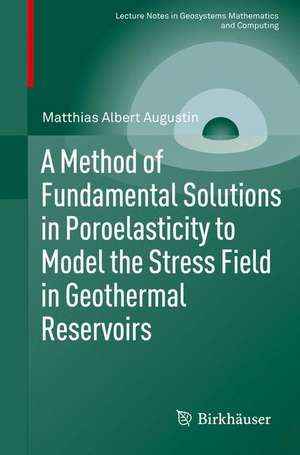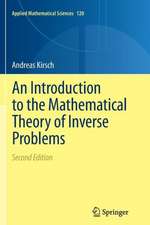A Method of Fundamental Solutions in Poroelasticity to Model the Stress Field in Geothermal Reservoirs: Lecture Notes in Geosystems Mathematics and Computing
Autor Matthias Albert Augustinen Limba Engleză Paperback – 23 iul 2015
The aim of this thesis is to develop a numerical solution scheme by means of which the fluid pressure and rock stresses in a geothermal reservoir can be determined prior to well drilling and during production. For this purpose, the method should (i) include poroelastic effects, (ii) provide a means of including thermoelastic effects, (iii) be inexpensive in terms of memory and computational power, and (iv) be flexible with regard to the locations of data points.
After introducing the basic equations and their relations to more familiar ones (the heat equation, Stokes equations, Cauchy-Navier equation), the “method of fundamental solutions” and its potential value concerning our task are discussed. Based on the properties of the fundamental solutions, theoretical results are established and numerical examples of stress field simulations are presented to assess the method’s performance. The first-ever 3D graphics calculated for these topics, which neither requiring meshing of the domain nor involving a time-stepping scheme, make this a pioneering volume.
Preț: 385.47 lei
Nou
Puncte Express: 578
Preț estimativ în valută:
73.76€ • 76.86$ • 61.07£
73.76€ • 76.86$ • 61.07£
Carte tipărită la comandă
Livrare economică 03-17 aprilie
Preluare comenzi: 021 569.72.76
Specificații
ISBN-13: 9783319170787
ISBN-10: 3319170783
Pagini: 270
Ilustrații: XII, 235 p. 69 illus., 32 illus. in color.
Dimensiuni: 155 x 235 x 17 mm
Greutate: 0.35 kg
Ediția:1st ed. 2015
Editura: Springer International Publishing
Colecția Birkhäuser
Seria Lecture Notes in Geosystems Mathematics and Computing
Locul publicării:Cham, Switzerland
ISBN-10: 3319170783
Pagini: 270
Ilustrații: XII, 235 p. 69 illus., 32 illus. in color.
Dimensiuni: 155 x 235 x 17 mm
Greutate: 0.35 kg
Ediția:1st ed. 2015
Editura: Springer International Publishing
Colecția Birkhäuser
Seria Lecture Notes in Geosystems Mathematics and Computing
Locul publicării:Cham, Switzerland
Public țintă
ResearchCuprins
1.Introduction.- 2. Preliminaries.- 3. Physical and Mathematical Foundation.- 4. Boundary Layer Potentials in Poroelasticity.- 5. Methods of Fundamental Solutions in Poroelasticity.- 6. Numerical Results.- 7. Conclusion and Outlook.- A. Fundamental Stresses and Fluid Velocities.- Bibliography.
Textul de pe ultima copertă
This monograph focuses on the numerical methods needed in the context of developing a reliable simulation tool to promote the use of renewable energy. One very promising source of energy is the heat stored in the Earth’s crust, which is harnessed by so-called geothermal facilities. Scientists from fields like geology, geo-engineering, geophysics and especially geomathematics are called upon to help make geothermics a reliable and safe energy production method. One of the challenges they face involves modeling the mechanical stresses at work in a reservoir.
The aim of this thesis is to develop a numerical solution scheme by means of which the fluid pressure and rock stresses in a geothermal reservoir can be determined prior to well drilling and during production. For this purpose, the method should (i) include poroelastic effects, (ii) provide a means of including thermoelastic effects, (iii) be inexpensive in terms of memory and computational power, and (iv) be flexible with regard to the locations of data points.
After introducing the basic equations and their relations to more familiar ones (the heat equation, Stokes equations, Cauchy-Navier equation), the “method of fundamental solutions” and its potential value concerning our task are discussed. Based on the properties of the fundamental solutions, theoretical results are established and numerical examples of stress field simulations are presented to assess the method’s performance. The first-ever 3D graphics calculated for these topics, which neither requiring meshing of the domain nor involving a time-stepping scheme, make this a pioneering volume.
The aim of this thesis is to develop a numerical solution scheme by means of which the fluid pressure and rock stresses in a geothermal reservoir can be determined prior to well drilling and during production. For this purpose, the method should (i) include poroelastic effects, (ii) provide a means of including thermoelastic effects, (iii) be inexpensive in terms of memory and computational power, and (iv) be flexible with regard to the locations of data points.
After introducing the basic equations and their relations to more familiar ones (the heat equation, Stokes equations, Cauchy-Navier equation), the “method of fundamental solutions” and its potential value concerning our task are discussed. Based on the properties of the fundamental solutions, theoretical results are established and numerical examples of stress field simulations are presented to assess the method’s performance. The first-ever 3D graphics calculated for these topics, which neither requiring meshing of the domain nor involving a time-stepping scheme, make this a pioneering volume.
Caracteristici
First approach to use a method of fundamental solutions for a coupled system of PDEs of different types, in particular a vector-valued elliptic one and a scalar-valued one of Sobolev-evolution type Progress in deep geothermics New methods in 3D numerics for poroelasticity Includes supplementary material: sn.pub/extras























